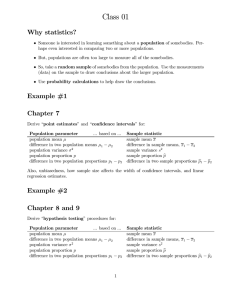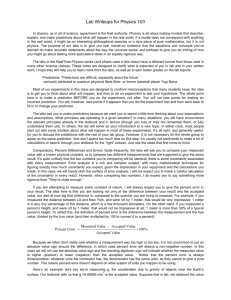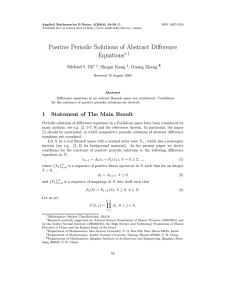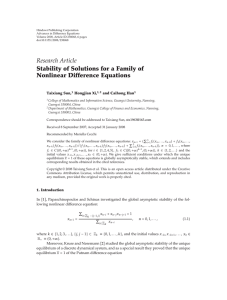Document 10851630
advertisement
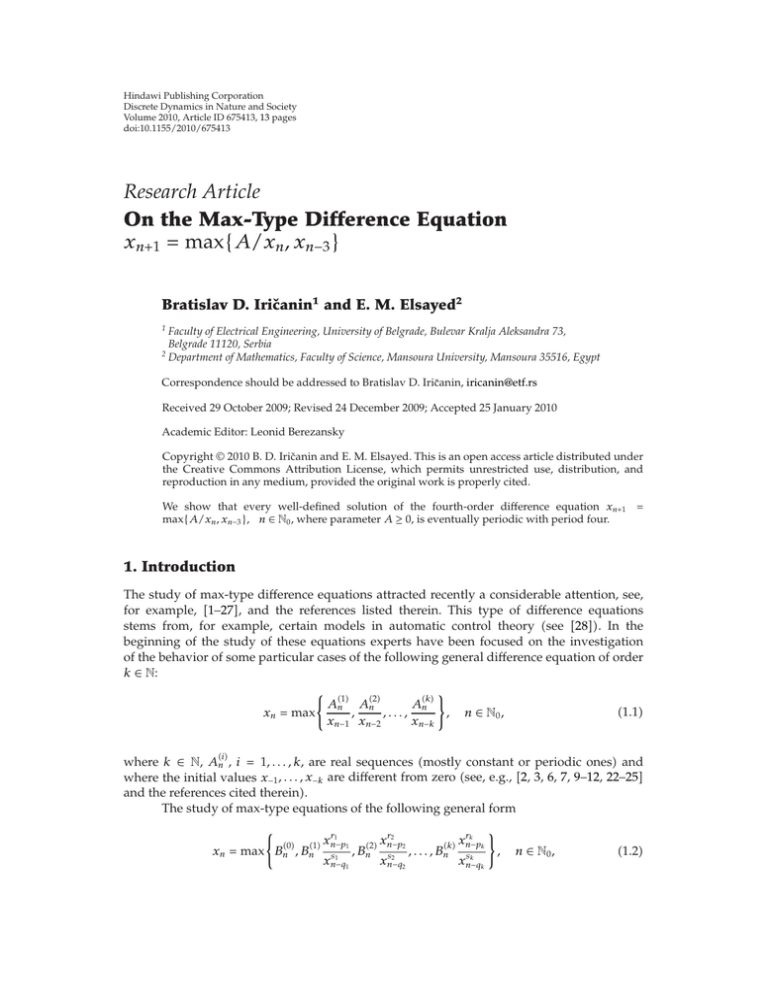
Hindawi Publishing Corporation
Discrete Dynamics in Nature and Society
Volume 2010, Article ID 675413, 13 pages
doi:10.1155/2010/675413
Research Article
On the Max-Type Difference Equation
xn1 max{A/xn , xn−3 }
Bratislav D. Iričanin1 and E. M. Elsayed2
1
Faculty of Electrical Engineering, University of Belgrade, Bulevar Kralja Aleksandra 73,
Belgrade 11120, Serbia
2
Department of Mathematics, Faculty of Science, Mansoura University, Mansoura 35516, Egypt
Correspondence should be addressed to Bratislav D. Iričanin, iricanin@etf.rs
Received 29 October 2009; Revised 24 December 2009; Accepted 25 January 2010
Academic Editor: Leonid Berezansky
Copyright q 2010 B. D. Iričanin and E. M. Elsayed. This is an open access article distributed under
the Creative Commons Attribution License, which permits unrestricted use, distribution, and
reproduction in any medium, provided the original work is properly cited.
We show that every well-defined solution of the fourth-order difference equation xn1 max{A/xn , xn−3 }, n ∈ N0 , where parameter A ≥ 0, is eventually periodic with period four.
1. Introduction
The study of max-type difference equations attracted recently a considerable attention, see,
for example, 1–27, and the references listed therein. This type of difference equations
stems from, for example, certain models in automatic control theory see 28. In the
beginning of the study of these equations experts have been focused on the investigation
of the behavior of some particular cases of the following general difference equation of order
k ∈ N:
1
2
k
A n An
An
,
,...,
,
xn max
xn−1 xn−2
xn−k
1.1
n ∈ N0 ,
i
where k ∈ N, An , i 1, . . . , k, are real sequences mostly constant or periodic ones and
where the initial values x−1 , . . . , x−k are different from zero see, e.g., 2, 3, 6, 7, 9–12, 22–25
and the references cited therein.
The study of max-type equations of the following general form
xn max
r1
0
1 xn−p1
Bn , Bn s 1
xn−q1
r2
2 xn−p2
, Bn s 2
xn−q2
rk
k xn−pk
, . . . , Bn sk
xn−qk
,
n ∈ N0 ,
1.2
2
Discrete Dynamics in Nature and Society
where k ∈ N, pi , qi are natural numbers such that p1 < p2 < · · · < pk , q1 < q2 < · · · < qk ,
j
ri , si ∈ R and Bn , j 0, 1, . . . , k, are sequences of real numbers, was proposed by Stević
in numerous talks, for example, in 13, 14. For some results in this direction see 1, 4, 15–
17, 19–21, 26, 27. For some nonlinear difference equations related to 1.2 see, for example,
7, 15, 17, 18, 29–38.
Definition 1.1. A sequence xn ∞
n−k is said to be eventually periodic with period p if there is an
index n0 ∈ {−k, . . . , −1, 0, 1, . . .} such that xnp xn for all n ≥ n0 . Specially, if n0 −k, then
the sequence xn ∞
n−k is periodic with period p.
Motivated by some ideas due to Stević e.g., the main lemmas there, Lemmas 3.1 and
3.2 are suggested by him, the authors of 26 considered the following second-order maxtype difference equation:
xn1
1
max
, Axn−1 ,
xn
n ∈ N0 .
1.3
Equation1.3 is not difficult for handling since, by the change yn xn xn−1 , it is transformed
into one of the following first-order difference equations
yn1 max 1, Ayn
or yn1 min 1, Ayn .
1.4
Using these equations, it is easy to see that for the case A 1 every solution of 1.3 is
eventually periodic with period two.
Recently, in the paper 5 it was showed that every solution of the third-order maxtype difference equation
xn1 max
A
, xn−2 ,
xn
n ∈ N0 ,
1.5
where the initial conditions x−2 , x−1 , x0 are arbitrary nonzero real numbers and A ∈ R, is
eventually periodic with period three. The fact that all solutions of 1.5 are periodic is not a
surprising fact for an explanation see 4.
For some recent papers on difference equations all the solutions of which are periodic
see, for example, 7, 39–45 and the references cited therein.
Here we show that every well-defined solution of the following fourth-order max-type
difference equation
xn1 max
A
, xn−3 ,
xn
n ∈ N0 ,
where the parameter A ∈ R ∪ {0}, is eventually periodic with period four.
1.6
Discrete Dynamics in Nature and Society
3
Remark 1.2. Note that if A 0, then 1.6 becomes xn1 xn−3 , from which it follows that
every solution is periodic with period four. Hence, in the sequel we will consider the case
A/
0.
In the sequel we will frequently use the following simple lemma, given without a proof
for related results see 4, 5.
Lemma 1.3. Assume that xn ∞
n−3 is a solution of 1.6 and there is k0 ∈ N0 ∪ {−3, −2, −1} such
that
xk0 xk0 4 ,
xk0 1 xk0 5 ,
xk0 2 xk0 6 ,
xk0 3 xk0 7 .
1.7
Then this solution is eventually periodic with period four.
2. Main Results
In this subsection we give a specific form of the solutions of the difference equation 1.6 when
the parameter A > 0 and in each case we can deduce that every solution of this equation is
periodic with period four.
Depending on the positivity of four initial values of 1.6, there are the following 16
cases to be considered:
i x−3 , x−2 , x−1 , x0 > 0,
ii
x−3 , x−2 , x−1 , x0 < 0,
iii x0 < 0,
x−3 , x−2 , x−1 > 0,
iv
x−1 < 0,
x−3 , x−2 , x0 > 0,
v
x−3 , x−1 , x0 > 0,
vi
x−3 < 0,
x−2 , x−1 , x0 > 0,
vii
x−2 < 0,
x0 , x−1 < 0,
viii x0 , x−2 < 0,
x−3 , x−2 > 0,
ix
x0 , x−3 < 0,
x−1 , x−2 > 0,
x
xi
x−1 , x−3 < 0,
x0 , x−2 > 0,
xii
xiii
xv
x0 , x−1 , x−2 < 0,
x0 , x−2 , x−3 < 0,
x−1 , x−2 < 0,
x−2 , x−3 < 0,
x−3 , x−1 > 0,
x0 , x−3 > 0,
x0 , x−1 > 0,
xiv x0 , x−1 , x−3 < 0,
x−3 > 0,
xvi x−1 , x−2 , x−3 < 0,
x−1 > 0,
2.1
x−2 > 0,
x0 > 0.
First, we prove another auxiliary result.
Lemma 2.1. Assume that the parameter A > 0. Then every solution of 1.6 is eventually positive if
initial values satisfy one of conditions (i), (iii)–(xvi).
Proof. If x0 > 0 or x−3 > 0, then
x1 max
A
, x−3
x0
> 0.
From this, 1.6, and by induction it follows that xn > 0 for every n ∈ N0 .
2.2
4
Discrete Dynamics in Nature and Society
If x−2 > 0, then
A
, x−2
x1
x2 max
> 0.
2.3
From this, 1.6, and by induction it follows that xn > 0 for every n ≥ 2.
If x−1 > 0, then
A
x3 max
, x−1
x1
> 0.
2.4
Similar to the previous case, by induction it follows that xn > 0 for every n ≥ 3.
Now, we can formulate and prove our main results.
Theorem 2.2. Assume that the parameter A > 0. Then every solution of 1.6 with positive initial
values is eventually periodic with period four.
Proof. From 1.6, we see that
x1 max
A
, x−3 .
x0
2.5
We consider the following two cases.
a1 x1 A/x0 . In this case A/x0 ≥ x−3 , and we see that
x2 max
A
, x−2
x1
max{x0 , x−2 }.
2.6
Now, there exists two subcases.
a11 x2 x0 , which occurs when x0 ≥ x−2 . We have
x3 max
A
, x−1
x2
max
A
, x−1 .
x0
2.7
a111 If x−1 ≥ A/x0 , then x3 x−1 , and
A
, x0 x0 ,
x−1
A A
A
A
x5 max
, x1 max
,
,
x4
x0 x0
x0
A
x6 max
, x2 max{x0 , x0 } x0 .
x5
x4 max
A
, x0
x3
max
2.8
Discrete Dynamics in Nature and Society
5
Hence, x3 x−1 , x4 x0 , x5 x1 , and x6 x2 , which implies that xn ∞
n−3 is an eventually
from x−1 periodic solution with period four. In this case we see that the solution has the
following form:
A
A
x−3 , x−2 , x−1 , x0 , , x0 , x−1 , x0 , , x0 , . . . .
x0
x0
2.9
a112 If A/x0 ≥ x−1 , then x3 A/x0 , and
x4 max
x5 max
A
, x0
x3
A
, x1
x4
max{x0 , x0 } x0 ,
max
A A
,
x0 x0
A
,
x0
A
, x2 max{x0 , x0 } x0 ,
x6 max
x5
A
A A
A
x7 max
, x3 max
,
.
x6
x0 x0
x0
2.10
Hence, x4 x0 , x5 x1 , x6 x2 , and x7 x3 , which implies that xn ∞
n−3 is an eventually
from x0 periodic solution with period four in this case minimal period is two. This
solution takes the form
A
A
A
A
x−3 , x−2 , x−1 , x0 , , x0 , , x0 , , x0 , , . . . .
x0
x0
x0
x0
2.11
a12 x2 x−2 , which occurs when x−2 ≥ x0 , and
x3 max
A
, x−1
x2
max
A
, x−1 .
x−2
2.12
A
, x0 .
x−1
2.13
a121 If x−1 ≥ A/x−2 , then x3 x−1 , and
x4 max
A
, x0
x3
max
a1211 If x0 ≥ A/x−1 , then x4 x0 , and
A
x5 max
, x1
x4
A A
,
max
x0 x0
A
.
x0
2.14
6
Discrete Dynamics in Nature and Society
Hence, x2 x−2 , x3 x−1 , x4 x0 , and x5 x1 , which implies that xn ∞
n−3 is an eventually
from x−2 periodic solution with period four. It can be written in the form
xn ∞
n−3 x−3 , x−2 , x−1 , x0 ,
A
A
, x−2 , x−1 , x0 , , . . . .
x0
x0
2.15
a1212 If A/x−1 ≥ x0 , then x4 A/x−1 , and
x5 max
x6 max
A
, x1
x4
A
, x2
x5
A
A
,
max x−1 ,
x0
x0
max{x0 , x−2 } x−2 ,
A
A
x7 max
, x3 max
, x−1 x−1 ,
x6
x−2
A
A A
A
x8 max
, x4 max
,
.
x7
x−1 x−1
x−1
2.16
Hence, x5 x1 , x6 x2 , x7 x3 , and x8 x4 , which implies that xn ∞
n−3 is an eventually
from x1 periodic solution with period four. Moreover, it can be written as follows:
xn ∞
n−3 A
A A
A
x−3 , x−2 , x−1 , x0 , , x−2 , x−1 ,
, , x−2 , x−1 ,
,... .
x0
x−1 x0
x−1
2.17
a122 If A/x−2 ≥ x−1 , then x3 A/x−2 , and
x4
x5
x6
x7
x8
A
max
, x0 max{x−2 , x0 } x−2 ,
x3
A
A A
A
max
, x1 max
,
,
x4
x−2 x0
x0
A
max
, x2 max{x0 , x−2 } x−2 ,
x5
A A
A
A
max
, x3 max
,
,
x6
x−2 x−2
x−2
A
max
, x4 max{x−2 , x−2 } x−2 .
x7
2.18
As above, the solution is eventually from x1 periodic with period four and it has the form
A
A
A
A
A
x−3 , x−2 , x−1 , x0 , , x−2 ,
, x−2 , , x−2 ,
, x−2 , , . . . .
x0
x−2
x0
x−2
x0
2.19
Discrete Dynamics in Nature and Society
7
a2 x1 x−3 . In this case x−3 ≥ A/x0 , and we see that
A
x2 max
, x−2
x1
A
, x−2 .
max
x−3
2.20
There again exist two subcases.
a21 x2 A/x−3 , which occurs when A/x−3 ≥ x−2 . So,
x3 max
A
, x−1
x2
max{x−3 , x−1 }.
2.21
a211 If x−3 ≥ x−1 , then x3 x−3 , and
x4
x5
x6
x7
A
A
max
, x0 max
, x0 x0 ,
x3
x−3
A
A
max
, x1 max
, x−3 x−3 ,
x4
x0
A
A A
A
max
, x2 max
,
,
x5
x−3 x−3
x−3
A
max
, x3 max{x−3 , x−3 } x−3 .
x6
Then we see that the solution is
A
A
A
, x−3 , x0 , x−3 ,
, x−3 , x0 , x−3 ,
,... ,
x−3 , x−2 , x−1 , x0 , x−3 ,
x−3
x−3
x−3
2.22
2.23
and xn ∞
n−3 is an eventually from x0 periodic solution with period four.
a212 If x−1 ≥ x−3 , then x3 x−1 , and
A
A
x4 max
, x0 max
, x0 x0 ,
x3
x−1
A
A
x5 max
, x1 max
, x−3 x−3 ,
x4
x0
A A
A
A
x6 max
, x2 max
,
.
x5
x−3 x−3
x−3
2.24
So, the solution takes the following form which is an eventually from x−1 periodic solution
with period four:
A
A
, x−1 , x0 , x−3 ,
,... .
x−3 , x−2 , x−1 , x0 , x−3 ,
x−3
x−3
2.25
8
Discrete Dynamics in Nature and Society
a22 x2 x−2 , which occurs when x−2 ≥ A/x−3 . So,
x3 max
A
, x−1
x2
max
A
, x−1 .
x−2
2.26
A
, x0 .
x−1
2.27
a221 If x−1 ≥ A/x−2 , then x3 x−1 , and
x4 max
A
, x0
x3
max
a2211 If x0 ≥ A/x−1 , then x4 x0 .
Therefore xn ∞
n−3 is a periodic solution with period four and the solution takes the
form
x−3 , x−2 , x−1 , x0 , x−3 , x−2 , x−1 , x0 , . . ..
2.28
a2212 If A/x−1 ≥ x0 , then x4 A/x−1 , and
A
, x1 max{x−1 , x−3 } x−3 ,
x4
A
A
x6 max
, x2 max
, x−2 x−2 ,
x5
x−3
A
A
x7 max
, x3 max
, x−1 x−1 ,
x6
x−2
A
A A
A
, x4 max
,
.
x8 max
x7
x−1 x−1
x−1
x5 max
2.29
Therefore, again xn ∞
n−3 is an eventually from x1 periodic solution with period four and
the solution takes the form
A
A
, x−3 , x−2 , x−1 ,
,... .
x−3 , x−2 , x−1 , x0 , x−3 , x−2 , x−1 ,
x−1
x−1
2.30
a222 If A/x−2 ≥ x−1 , then x3 A/x−2 , and
A
x4 max
, x0
x3
max{x−2 , x0 }.
2.31
Discrete Dynamics in Nature and Society
9
a2221 If x−2 ≥ x0 , then x4 x−2 , and
x5 max
x6 max
A
, x1
x4
A
, x2
x5
max
max
A
, x−3
x−2
A
, x−2
x−3
x−3 ,
x−2 ,
A
A A
A
x7 max
, x3 max
,
,
x6
x−2 x−2
x−2
A
, x4 max{x−2 , x−2 } x−2 .
x8 max
x7
2.32
Thus, the solution is in the following form which is eventually from x1 periodic with period
four:
A
A
, x−2 , x−3 , x−2 ,
, x−2 , . . . .
x−3 , x−2 , x−1 , x0 , x−3 , x−2 ,
x−2
x−2
2.33
a2222 If x0 ≥ x−2 , then x4 x0 , and
A
A
, x1 max
, x−3 x−3 ,
x4
x0
A
A
x6 max
, x2 max
, x−2 x−2 ,
x5
x−3
A A
A
A
x7 max
, x3 max
,
.
x6
x−2 x−2
x−2
x5 max
2.34
Thus, the solution is of the following form
A
A
x−3 , x−2 , x−1 , x0 , x−3 , x−2 ,
, x0 , x−3 , x−2 ,
,... .
x−2
x−2
2.35
Therefore xn ∞
n−3 is eventually from x0 periodic with period four. The proof is completed.
From Lemma 1.3 and Theorem 2.2 we obtain the following result.
Theorem 2.3. Assume the parameter A > 0 and that initial values of 1.6 satisfy one of conditions
(i), (iii)–(xvi) in Lemma 2.1. Then every such solution of 1.6 is eventually periodic with period four.
Proof. If initial values of 1.6 satisfy one of conditions i, iii–xvi in Lemma 2.1, then by
the same lemma it follows that the corresponding solution is eventually positive. This means
that there is k1 ∈ N0 ∪ {−3, −2, −1} such that xn > 0 for every n ≥ k1 . In particular, we have
10
Discrete Dynamics in Nature and Society
that xk1 , xk1 1 , xk1 2 , xk1 3 > 0. Since equation 1.6 is autonomous if xn ∞
n−3 is a solution of
1.6, then yn xnk1 3 is also a solution of 1.6 but such that y−3 , y−2 , y−1 , y0 > 0. Hence, the
problem is reduced to the case when all the initial values are positive. Applying Theorem 2.2,
the result follows.
In the next theorem we study those solutions of 1.6 such that x−3 , x−2 , x−1 , x0 < 0. We
would like to thank Professor Stević for giving us the elegant proof below which drastically
reduced our original proof.
Theorem 2.4. Assume that the parameter A > 0 and all the initial values are negative
x−3 , x−2 , x−1 , x0 < 0. Then every solution of 1.6 is eventually periodic with period four.
Proof. Since x−3 < 0, x−2 < 0,√x−1 < 0, x0 < 0, and A > 0, by induction we have xn < 0 for each
n ∈ N. By the change xn − A/zn , 1.6 becomes
zn1 −1
1
1
min zn ,
max
, zn−3 ,
zn−3
zn
2.36
where zn > 0 for every n ≥ −3. Hence by Theorem 2.2 the result follows.
Since all the cases are reduced to the case when all initial values are positive, it is of
interest to investigate this case in more details. The next theorem describes all eventually
constant solutions of 1.6. Our idea stems from 46 see also 47–50.
Theorem 2.5. Assume that the parameter A > 0. Then all positive solutions to 1.6 which are
eventually equal to the positive equilibrium have the following form:
1, c, b, 1, 1, 1, . . .,
for some b, c ∈ 0, 1.
2.37
√
Proof. First note that by the change xn Ayn the problem is reduced to the case A 1.
1. Then 1 xk max{1/a, xk−4 },
Assume that xn 1 for n ≥ k and xk−1 a /
k ≥ 1, which implies xk−4 1 and a > 1. On the other hand, we have 1 xk3 max{1/xk2 , xk−1 } max{1, a}, so that a < 1, which is a contradiction. Hence k ≤ 0,
that is, xn d, c, b, 1, 1, 1, . . .. Since x1 1, we get x−3 1 case k 1 above. Since
1 x2 max{x1 , x−2 } max{1, c} and 1 x3 max{x2 , x−1 } max{1, b}, it follows that
b, c ∈ 0, 1, as claimed.
3. Conclusions and Future Works
We finish this article with some comments which can motivate further works.
Case A < 0
The case when the parameter A is negative is not treated in this article. By similar calculations
as above, we have managed to show that all the solutions of 1.6 are eventually periodic
with period four in many subcases. However, there are too many subcases and calculations
without some new ideas, so we decided not to present any result when A < 0. We conjecture
Discrete Dynamics in Nature and Society
11
that every solution of 1.6, when A < 0, is eventually periodic with the same period four.
What is more interesting is to find a reasonably short proof of the conjecture without using
tiresome calculations similar to those in Theorem 2.2.
Periodicity
We also want to mention that in 4 we proved that every solution of the equation
xn1
A
max
, xn−l ,
xn−k
n ∈ N0 ,
3.1
where k, l ∈ N0 , is periodic. It is of some interest to find the minimal period of the equation,
as well as to get a general result concerning this problem.
Acknowledgments
The authors would like to express their sincere thanks to the anonymous referees for
numerous comments which considerably improved this article. The research of the first
author was partly supported by the Serbian Ministry of Science, through The Mathematical
Institute of SASA, Belgrade, Project no. 144013.
References
1 K. S. Berenhaut, J. D. Foley, and S. Stević, “Boundedness character of positive solutions of a max
difference equation,” Journal of Difference Equations and Applications, vol. 12, no. 12, pp. 1193–1199,
2006.
2 C. Çinar, S. Stević, and I. Yalçinkaya, “On positive solutions of a reciprocal difference equation with
minimum,” Journal of Applied Mathematics & Computing, vol. 17, no. 1-2, pp. 307–314, 2005.
3 E. M. Elabbasy, H. El-Metwally, and E. M. Elsayed, “On the periodic nature of some max-type
difference equations,” International Journal of Mathematics and Mathematical Sciences, vol. 2005, no. 14,
pp. 2227–2239, 2005.
4 E. M. Elsayed, B. Iričanin, and S. Stević, “On the max-type equation xn1 max{An /xn , xn−1 },” to
appear in Ars Combinatoria.
5 E. M. Elsayed and S. Stević, “On the max-type equation xn1 {A/xn , xn−2 },” Nonlinear Analysis:
Theory, Methods & Applications, vol. 71, no. 3-4, pp. 910–922, 2009.
6 J. Feuer, “On the eventual periodicity of xn1 max{1/xn , An /xn−1 } with a period-four parameter,”
Journal of Difference Equations and Applications, vol. 12, no. 5, pp. 467–486, 2006.
7 E. A. Grove and G. Ladas, Periodicities in Nonlinear Ddifference Equations, vol. 4 of Advances in Discrete
Mathematics and Applications, Chapman & Hall/CRC, Boca Raton, Fla, USA, 2005.
8 B. D. Iričanin, The qualitative analysis of some classes of nonlinear difference equations, Ph.D. thesis,
Prirodno-matematički fakultet, Univerzitet u Novom Sadu, Novi Sad, Serbia, 2009.
9 C. M. Kent and M. A. Radin, “On the boundedness nature of positive solutions of the difference
equation xn1 max{An /xn , Bn /xn−1 } with periodic parameters,” Dynamics of Continuous, Discrete &
Impulsive Systems. Series B, vol. 2003, supplement, pp. 11–15, 2003.
10 D. P. Mishev, W. T. Patula, and H. D. Voulov, “A reciprocal difference equation with maximum,”
Computers & Mathematics with Applications, vol. 43, no. 8-9, pp. 1021–1026, 2002.
11 D. P. Mishev, W. T. Patula, and H. D. Voulov, “Periodic coefficients in a reciprocal difference equation
with maximum,” PanAmerican Mathematical Journal, vol. 13, no. 3, pp. 43–57, 2003.
12 W. T. Patula and H. D. Voulov, “On a max type recurrence relation with periodic coefficients,” Journal
of Difference Equations and Applications, vol. 10, no. 3, pp. 329–338, 2004.
13 S. Stević, “Some open problems and conjectures on difference equations,” http://www.mi.sanu.ac
.rs/colloquiums/mathcoll programs/mathcoll.apr2004.htm.
12
Discrete Dynamics in Nature and Society
14 S. Stević, “Boundedness character of a max-type difference equation,” in Book of Abstracts, Conference
in Honour of Allan Peterson, p. 28, Novacella, Italy, July-August 2007.
p
r
,” Discrete Dynamics in Nature and Society,
15 S. Stević, “On the recursive sequence xn1 A xn /xn−1
vol. 2007, Article ID 40963, 9 pages, 2007.
p
p
16 S. Stević, “On the recursive sequence xn1 max{c, xn /xn−1 },” Applied Mathematics Letters, vol. 21, no.
8, pp. 791–796, 2008.
17 S. Stević, “Boundedness character of a class of difference equations,” Nonlinear Analysis: Theory,
Methods & Applications, vol. 70, no. 2, pp. 839–848, 2009.
18 S. Stević, “Boundedness character of two classes of third-order difference equations,” Journal of
Difference Equations and Applications, vol. 15, no. 11-12, pp. 1193–1209, 2009.
19 S. Stević, “Global stability of a difference equation with maximum,” Applied Mathematics and
Computation, vol. 210, no. 2, pp. 525–529, 2009.
20 S. Stević, “On a generalized max-type difference equation from automatic control theory,” Nonlinear
Analysis: Theory, Methods & Applications, vol. 72, no. 3-4, pp. 1841–1849, 2010.
21 F. Sun, “On the asymptotic behavior of a difference equation with maximum,” Discrete Dynamics in
Nature and Society, vol. 2008, Article ID 243291, 6 pages, 2008.
22 I. Szalkai, “On the periodicity of the sequence xn1 max{A0 /xn , A1 /xn−1 , . . . , Ak /xn−k },” Journal of
Difference Equations and Applications, vol. 5, no. 1, pp. 25–29, 1999.
23 H. D. Voulov, “Periodic solutions to a difference equation with maximum,” Proceedings of the American
Mathematical Society, vol. 131, no. 7, pp. 2155–2160, 2003.
24 H. D. Voulov, “On the periodic nature of the solutions of the reciprocal difference equation with
maximum,” Journal of Mathematical Analysis and Applications, vol. 296, no. 1, pp. 32–43, 2004.
25 H. D. Voulov, “On a difference equation with periodic coefficients,” Journal of Difference Equations and
Applications, vol. 13, no. 5, pp. 443–452, 2007.
26 I. Yalçinkaya, B. D. Iričanin, and C. Çinar, “On a max-type difference equation,” Discrete Dynamics in
Nature and Society, vol. 2007, Article ID 47264, 10 pages, 2007.
27 X. Yang, X. Liao, and C. Li, “On a difference equation wtih maximum,” Applied Mathematics and
Computation, vol. 181, no. 1, pp. 1–5, 2006.
28 E. P. Popov, Automatic Regulation and Control, Nauka, Moscow, Russia, 1966.
29 K. S. Berenhaut and S. Stević, “The behaviour of the positive solutions of the difference equation
xn A xn−2 /xn−1 p ,” Journal of Difference Equations and Applications, vol. 12, no. 9, pp. 909–918, 2006.
30 L. Gutnik and S. Stević, “On the behaviour of the solutions of a second-order difference equation,”
Discrete Dynamics in Nature and Society, vol. 2007, Article ID 27562, 14 pages, 2007.
31 B. Iričanin and S. Stević, “On a class of third-order nonlinear difference equations,” Applied
Mathematics and Computation, vol. 213, no. 2, pp. 479–483, 2009.
32 S. Stević, “On the recursive sequence xn1 αn xn−1 /xn . II,” Dynamics of Continuous, Discrete &
Impulsive Systems. Series A, vol. 10, no. 6, pp. 911–916, 2003.
2k1
33 S. Stević, “On the recursive sequence xn1 A/ ki0 xn−i 1/ jk2 xn−j ,” Taiwanese Journal of
Mathematics, vol. 7, no. 2, pp. 249–259, 2003.
34 S. Stević, “A note on periodic character of a difference equation,” Journal of Difference Equations and
Applications, vol. 10, no. 10, pp. 929–932, 2004.
p
p
35 S. Stević, “On the recursive sequence xn1 αxn−1 /xn ,” Journal of Applied Mathematics & Computing,
vol. 18, no. 1-2, pp. 229–234, 2005.
36 S. Stević, “On the difference equation xn1 αxn−1 /xn ,” Computers & Mathematics with Applications,
vol. 56, no. 5, pp. 1159–1171, 2008.
37 S. Stević, “Boundedness character of a fourth order nonlinear difference equation,” Chaos, Solitons &
Fractals, vol. 40, no. 5, pp. 2364–2369, 2009.
38 S. Stević, “On a class of higher-order difference equations,” Chaos, Solitons & Fractals, vol. 42, no. 1,
pp. 138–145, 2009.
39 F. Balibrea and A. Linero, “On global periodicity of xn2 fxn1 , xn ,” in Difference Equations,
Special Functions and Orthogonal Polynomials. (Munich, July 25–30, 2005), pp. 41–50, World Scientific,
Hackensack, NJ, USA, 2007.
40 F. Balibrea, A. Linero Bas, G. S. López, and S. Stević, “Global periodicity of xnk1 fk xnk · · · f1 xn1 ,” Journal of Difference Equations and Applications, vol. 13, no. 10, pp. 901–910, 2007.
41 L. Berg and S. Stević, “Periodicity of some classes of holomorphic difference equations,” Journal of
Difference Equations and Applications, vol. 12, no. 8, pp. 827–835, 2006.
Discrete Dynamics in Nature and Society
13
42 R. P. Kurshan and B. Gopinath, “Recursively generated periodic sequences,” Canadian Journal of
Mathematics, vol. 26, pp. 1356–1371, 1974.
43 J. Rubió-Massegú and V. Mañosa, “Normal forms for rational difference equations with applications
to the global periodicity problem,” Journal of Mathematical Analysis and Applications, vol. 332, no. 2, pp.
896–918, 2007.
44 S. Stević, “On global periodicity of a class of difference equations,” Discrete Dynamics in Nature and
Society, vol. 2007, Article ID 23503, 10 pages, 2007.
45 S. Stević and K. S. Berenhaut, “The behaviour of the positive solutions of the difference equation
xn fxn−2 /gxn−1 ,” Abstract and Applied Analysis, vol. 2008, Article ID 53243, 9 pages, 2008.
46 S. Stevich, “Nontrivial solutions of higher-order rational difference equations,” Matematicheskie
Zametki, vol. 84, no. 5, pp. 772–780, 2008.
47 B. Iričanin and S. Stević, “Eventually constant solutions of a rational difference equation,” Applied
Mathematics and Computation, vol. 215, no. 2, pp. 854–856, 2009.
48 S. Stević, “Global stability and asymptotics of some classes of rational difference equations,” Journal
of Mathematical Analysis and Applications, vol. 316, no. 1, pp. 60–68, 2006.
49 S. Stević, “Asymptotics of some classes of higher-order difference equations,” Discrete Dynamics in
Nature and Society, vol. 2007, Article ID 56813, 20 pages, 2007.
50 S. Stević, “Existence of nontrivial solutions of a rational difference equation,” Applied Mathematics
Letters, vol. 20, no. 1, pp. 28–31, 2007.



